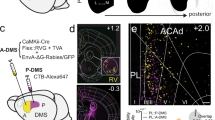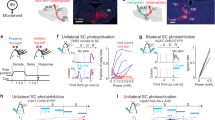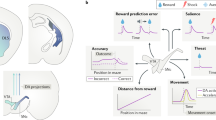Abstract
A choice that reliably produces a preferred outcome can be automated to liberate cognitive resources for other tasks. Should an outcome become less desirable, behavior must adapt in parallel or it becomes perseverative. Corticostriatal systems are known to mediate choice learning and flexibility, but the molecular mechanisms of these processes are not well understood. We integrated mouse behavioral, immunocytochemical, in vivo electrophysiological, genetic and pharmacological approaches to study choice. We found that the dorsal striatum (DS) was increasingly activated with choice learning, whereas reversal of learned choice engaged prefrontal regions. In vivo, DS neurons showed activity associated with reward anticipation and receipt that emerged with learning and relearning. Corticostriatal or striatal deletion of Grin2b (encoding the NMDA-type glutamate receptor subunit GluN2B) or DS-restricted GluN2B antagonism impaired choice learning, whereas cortical Grin2b deletion or OFC GluN2B antagonism impaired shifting. Our convergent data demonstrate how corticostriatal GluN2B circuits govern the ability to learn and shift choice behavior.
This is a preview of subscription content, access via your institution
Access options
Subscribe to this journal
Receive 12 print issues and online access
$209.00 per year
only $17.42 per issue
Buy this article
- Purchase on Springer Link
- Instant access to full article PDF
Prices may be subject to local taxes which are calculated during checkout








Similar content being viewed by others
References
Middleton, F.A. & Strick, P.L. Basal-ganglia 'projections' to the prefrontal cortex of the primate. Cereb. Cortex 12, 926–935 (2002).
Mainen, Z.F. & Kepecs, A. Neural representation of behavioral outcomes in the orbitofrontal cortex. Curr. Opin. Neurobiol. 19, 84–91 (2009).
Schoenbaum, G., Roesch, M.R., Stalnaker, T.A. & Takahashi, Y.K. A new perspective on the role of the orbitofrontal cortex in adaptive behaviour. Nat. Rev. Neurosci. 10, 885–892 (2009).
Balleine, B.W. & O'Doherty, J.P. Human and rodent homologies in action control: corticostriatal determinants of goal-directed and habitual action. Neuropsychopharmacology 35, 48–69 (2010).
Montague, P.R., King-Casas, B. & Cohen, J.D. Imaging valuation models in human choice. Annu. Rev. Neurosci. 29, 417–448 (2006).
Graybiel, A.M. Habits, rituals, and the evaluative brain. Annu. Rev. Neurosci. 31, 359–387 (2008).
Yin, H.H. & Knowlton, B.J. The role of the basal ganglia in habit formation. Nat. Rev. Neurosci. 7, 464–476 (2006).
Montague, P.R., Dayan, P. & Sejnowski, T.J. A framework for mesencephalic dopamine systems based on predictive Hebbian learning. J. Neurosci. 16, 1936–1947 (1996).
Floresco, S.B. & Jentsch, J.D. Pharmacological enhancement of memory and executive functioning in laboratory animals. Neuropsychopharmacology 36, 227–250 (2011).
Carli, M., Baviera, M., Invernizzi, R.W. & Balducci, C. Dissociable contribution of 5–HT1A and 5–HT2A receptors in the medial prefrontal cortex to different aspects of executive control such as impulsivity and compulsive perseveration in rats. Neuropsychopharmacology 31, 757–767 (2006).
Dang, M.T. et al. Disrupted motor learning and long-term synaptic plasticity in mice lacking NMDAR1 in the striatum. Proc. Natl. Acad. Sci. USA 103, 15254–15259 (2006).
Yin, H.H., Knowlton, B.J. & Balleine, B.W. Blockade of NMDA receptors in the dorsomedial striatum prevents action-outcome learning in instrumental conditioning. Eur. J. Neurosci. 22, 505–512 (2005).
Jin, X. & Costa, R.M. Start/stop signals emerge in nigrostriatal circuits during sequence learning. Nature 466, 457–462 (2010).
Monyer, H., Burnashev, N., Laurie, D.J., Sakmann, B. & Seeburg, P.H. Developmental and regional expression in the rat brain and functional properties of four NMDA receptors. Neuron 12, 529–540 (1994).
Brigman, J.L. et al. Loss of GluN2B-containing NMDA receptors in CA1 hippocampus and cortex impairs long-term depression, reduces dendritic spine density, and disrupts learning. J. Neurosci. 30, 4590–4600 (2010).
Duffy, S., Labrie, V. & Roder, J.C. d-Serine augments NMDA-NR2B receptor-dependent hippocampal long-term depression and spatial reversal learning. Neuropsychopharmacology 33, 1004–1018 (2008).
Dix, S., Gilmour, G., Potts, S., Smith, J.W. & Tricklebank, M. A within-subject cognitive battery in the rat: differential effects of NMDA receptor antagonists. Psychopharmacology (Berl.) 212, 227–242 (2010).
Higgins, G.A., Ballard, T.M., Enderlin, M., Haman, M. & Kemp, J.A. Evidence for improved performance in cognitive tasks following selective NR2B NMDA receptor antagonist pre-treatment in the rat. Psychopharmacology (Berl.) 179, 85–98 (2005).
von Engelhardt, J. et al. Contribution of hippocampal and extra-hippocampal NR2B-containing NMDA receptors to performance on spatial learning tasks. Neuron 60, 846–860 (2008).
Tang, Y.P. et al. Genetic enhancement of learning and memory in mice. Nature 401, 63–69 (1999).
Bussey, T.J. et al. New translational assays for preclinical modelling of cognition in schizophrenia: the touchscreen testing method for mice and rats. Neuropharmacology 62, 1191–1203 (2012).
Karlsson, R.M. et al. Assessment of glutamate transporter GLAST (EAAT1)-deficient mice for phenotypes relevant to the negative and executive/cognitive symptoms of schizophrenia. Neuropsychopharmacology 34, 1578–1589 (2009).
Brigman, J.L. et al. Pharmacological or genetic inactivation of the serotonin transporter improves reversal learning in mice. Cereb. Cortex 20, 1955–1963 (2010).
Graybeal, C. et al. Paradoxical reversal learning enhancement by stress or prefrontal cortical damage: rescue with BDNF. Nat. Neurosci. 14, 1507–1509 (2011).
Barnes, T.D., Kubota, Y., Hu, D., Jin, D.Z. & Graybiel, A.M. Activity of striatal neurons reflects dynamic encoding and recoding of procedural memories. Nature 437, 1158–1161 (2005).
Floresco, S.B., Zhang, Y. & Enomoto, T. Neural circuits subserving behavioral flexibility and their relevance to schizophrenia. Behav. Brain Res. 204, 396–409 (2009).
Alexander, W.H. & Brown, J.W. Medial prefrontal cortex as an action-outcome predictor. Nat. Neurosci. 14, 1338–1344 (2011).
Ragozzino, M.E. The contribution of the medial prefrontal cortex, orbitofrontal cortex, and dorsomedial striatum to behavioral flexibility. Ann. NY Acad. Sci. 1121, 355–375 (2007).
Corbit, L.H. & Janak, P.H. Posterior dorsomedial striatum is critical for both selective instrumental and Pavlovian reward learning. Eur. J. Neurosci. 31, 1312–1321 (2010).
Costa, R.M., Cohen, D. & Nicolelis, M.A. Differential corticostriatal plasticity during fast and slow motor skill learning in mice. Curr. Biol. 14, 1124–1134 (2004).
Dickinson, A. Actions and habits: the development of behavioural autonomy. Philos. Trans. R. Soc. Lond. B Biol. 308, 67–78 (1985).
Gage, G.J., Stoetzner, C.R., Wiltschko, A.B. & Berke, J.D. Selective activation of striatal fast-spiking interneurons during choice execution. Neuron 67, 466–479 (2010).
Kravitz, A.V. et al. Regulation of parkinsonian motor behaviours by optogenetic control of basal ganglia circuitry. Nature 466, 622–626 (2010).
Tang, C., Pawlak, A.P., Prokopenko, V. & West, M.O. Changes in activity of the striatum during formation of a motor habit. Eur. J. Neurosci. 25, 1212–1227 (2007).
Pasupathy, A. & Miller, E.K. Different time courses of learning-related activity in the prefrontal cortex and striatum. Nature 433, 873–876 (2005).
Yin, H.H. et al. Dynamic reorganization of striatal circuits during the acquisition and consolidation of a skill. Nat. Neurosci. 12, 333–341 (2009).
Schultz, W. et al. Explicit neural signals reflecting reward uncertainty. Phil. Trans. R. Soc. Lond. B 363, 3801–3811 (2008).
Calabresi, P., Maj, R., Pisani, A., Mercuri, N.B. & Bernardi, G. Long-term synaptic depression in the striatum: physiological and pharmacological characterization. J. Neurosci. 12, 4224–4233 (1992).
Ashby, F.G., Turner, B.O. & Horvitz, J.C. Cortical and basal ganglia contributions to habit learning and automaticity. Trends Cogn. Sci. 14, 208–215 (2010).
Wickens, J.R., Horvitz, J.C., Costa, R.M. & Killcross, S. Dopaminergic mechanisms in actions and habits. J. Neurosci. 27, 8181–8183 (2007).
Ryan, T.J. et al. Evolution of GluN2A/B cytoplasmic domains diversified vertebrate synaptic plasticity and behavior. Nat. Neurosci. 16, 25–32 (2013).
Brigman, J.L. et al. Impaired discrimination learning in mice lacking the NMDA receptor NR2A subunit. Learn. Mem. 15, 50–54 (2008).
Fukaya, M., Kato, A., Lovett, C., Tonegawa, S. & Watanabe, M. Retention of NMDA receptor NR2 subunits in the lumen of endoplasmic reticulum in targeted NR1 knockout mice. Proc. Natl. Acad. Sci. USA 100, 4855–4860 (2003).
Dalton, G.L., Wang, Y.T., Floresco, S.B. & Phillips, A.G. Disruption of AMPA receptor endocytosis impairs the extinction, but not acquisition of learned fear. Neuropsychopharmacology 33, 2416–2426 (2008).
Higgins, G.A., Ballard, T.M., Huwyler, J., Kemp, J.A. & Gill, R. Evaluation of the NR2B-selective NMDA receptor antagonist Ro 63–1908 on rodent behaviour: evidence for an involvement of NR2B NMDA receptors in response inhibition. Neuropharmacology 44, 324–341 (2003).
Kos, T., Nikiforuk, A., Rafa, D. & Popik, P. The effects of NMDA receptor antagonists on attentional set-shifting task performance in mice. Psychopharmacology (Berl.) 214, 911–921 (2011).
Vanderschuren, L.J., Di Ciano, P. & Everitt, B.J. Involvement of the dorsal striatum in cue-controlled cocaine seeking. J. Neurosci. 25, 8665–8670 (2005).
Bohn, I., Giertler, C. & Hauber, W. NMDA receptors in the rat orbital prefrontal cortex are involved in guidance of instrumental behaviour under reversal conditions. Cereb. Cortex 13, 968–976 (2003).
Parker, J.G., Beutler, L.R. & Palmiter, R.D. The contribution of NMDA receptor signaling in the corticobasal ganglia reward network to appetitive Pavlovian learning. J. Neurosci. 31, 11362–11369 (2011).
Wang, L.P. et al. NMDA receptors in dopaminergic neurons are crucial for habit learning. Neuron 72, 1055–1066 (2011).
Izquierdo, A. et al. Genetic and dopaminergic modulation of reversal learning in a touchscreen-based operant procedure for mice. Behav. Brain Res. 171, 181–188 (2006).
Hefner, K. et al. Impaired fear extinction learning and cortico-amygdala circuit abnormalities in a common genetic mouse strain. J. Neurosci. 28, 8074–8085 (2008).
Karlsson, R.M., Tanaka, K., Heilig, M. & Holmes, A. Loss of glial glutamate and aspartate transporter (excitatory amino acid transporter 1) causes locomotor hyperactivity and exaggerated responses to psychotomimetics: rescue by haloperidol and metabotropic glutamate 2/3 agonist. Biol. Psychiatry 64, 810–814 (2008).
Dahlin, E., Neely, A.S., Larsson, A., Backman, L. & Nyberg, L. Transfer of learning after updating training mediated by the striatum. Science 320, 1510–1512 10.1126/science.1155466 (2008).
Erickson, K.I. et al. Training-induced functional activation changes in dual-task processing: An fMRI study. Cereb. Cortex 17, 192–204 (2007).
Olesen, P.J., Westerberg, H. & Klingberg, T. Increased prefrontal and parietal activity after training of working memory. Nat. Neurosci. 7, 75–79 (2004).
Boyce-Rustay, J.M. & Holmes, A. Ethanol-related behaviors in mice lacking the NMDA receptor NR2A subunit. Psychopharmacology (Berl.) 187, 455–466 (2006).
Holmes, A. et al. Chronic alcohol remodels prefrontal neurons and disrupts NMDAR-mediated fear extinction encoding. Nat. Neurosci. 15, 1359–1361 (2012).
Acknowledgements
We are very grateful to G. Schoenbaum and A. Kravitz for discussions of the in vivo recording results and to G. Luo for mutant genotyping. J.L.B., C.G., T.W., M.I.D., R.A.D., M.P., O.G.-C., D.M.L. and A.H. were supported by the NIAAA Intramural Research Program. L.M.S. and T.J.B. were supported by The Wellcome Trust. Z.J. and K.N. were supported by the National Institute of Mental Health Intramural Research Program.
Author information
Authors and Affiliations
Contributions
J.L.B. conducted behavioral, c-Fos, in vivo electrophysiological and in situ hybridization experiments and contributed to writing the manuscript; R.A.D., C.G. and M.P. conducted behavioral experiments; T.W. conducted the slice electrophysiological experiments; O.G.-C. conducted RT-PCR and western blot experiments; M.I.D. contributed to the c-Fos experiments; Z.J. and S.J. contributed to the in situ hybridization experiments; L.M.S. and T.J.B. provided behavioral analysis software; D.M.L. supervised the slice electrophysiological experiments and contributed to writing the manuscript; K.N. supervised the in situ hybridization experiments, provided mutant mice and contributed to writing the manuscript; A.H. supervised the study and contributed to writing the manuscript.
Corresponding author
Ethics declarations
Competing interests
The authors declare no competing financial interests.
Supplementary information
Supplementary Figures and Text
Supplementary Figures 1–9 and Supplementary Table 1 (PDF 944 kb)
Rights and permissions
About this article
Cite this article
Brigman, J., Daut, R., Wright, T. et al. GluN2B in corticostriatal circuits governs choice learning and choice shifting. Nat Neurosci 16, 1101–1110 (2013). https://doi.org/10.1038/nn.3457
Received:
Accepted:
Published:
Issue Date:
DOI: https://doi.org/10.1038/nn.3457
This article is cited by
-
Mice carrying a schizophrenia-associated mutation of the Arhgap10 gene are vulnerable to the effects of methamphetamine treatment on cognitive function: association with morphological abnormalities in striatal neurons
Molecular Brain (2021)
-
Neuroanatomy and behavior in mice with a haploinsufficiency of AT-rich interactive domain 1B (ARID1B) throughout development
Molecular Autism (2021)
-
A molecular insight into the dissociable regulation of associative learning and motivation by the synaptic protein neuroligin-1
BMC Biology (2020)
-
Overexpression of astroglial major histocompatibility complex class I in the medial prefrontal cortex impairs visual discrimination learning in mice
Molecular Brain (2020)
-
A psychiatric disease-related circular RNA controls synaptic gene expression and cognition
Molecular Psychiatry (2020)



